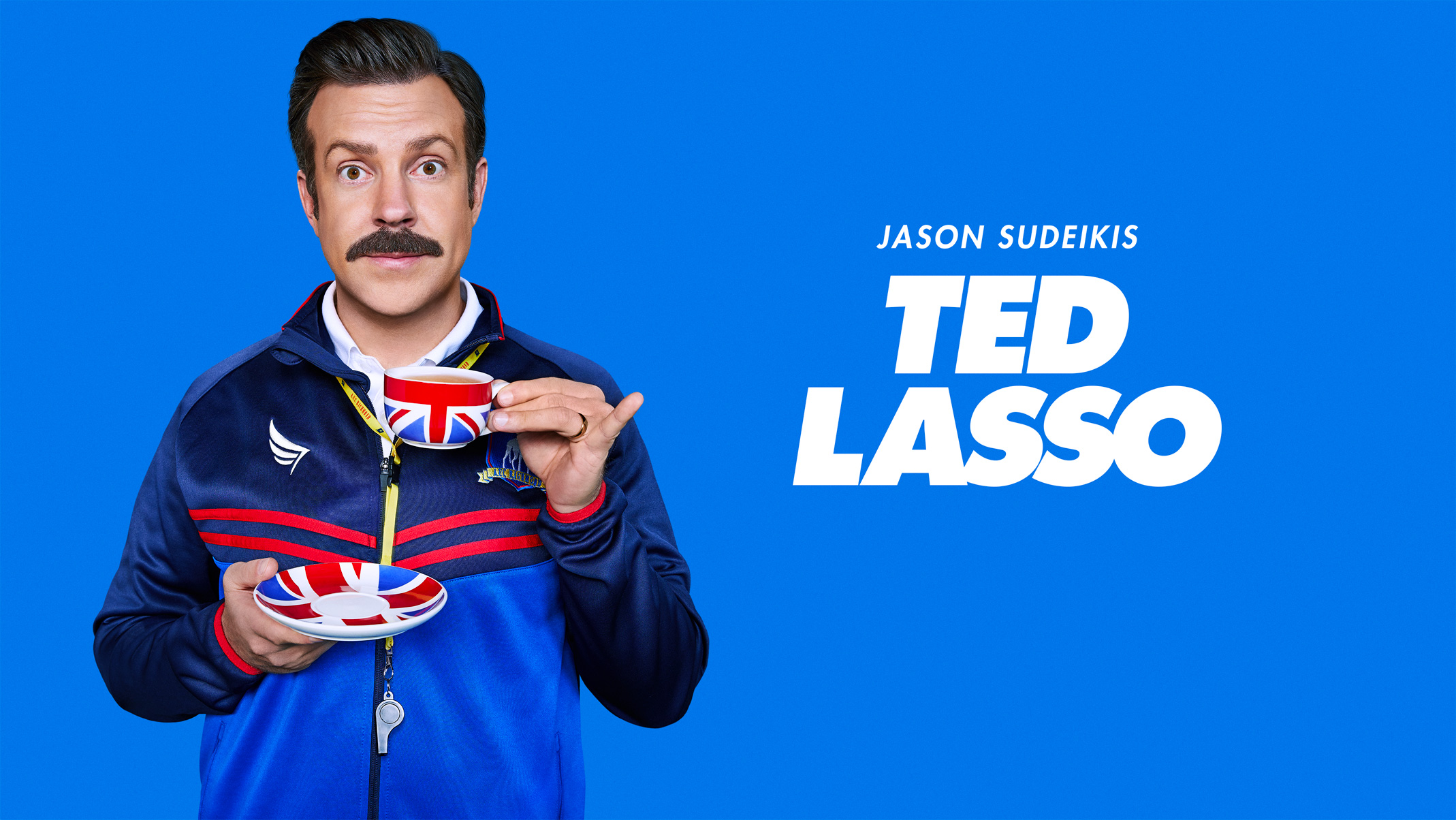Episode 1Ted Lasso, American football coach, is hired to coach Premier League team AFC Richmond by its new owner, the recently divorced Rebecca Welton. When he arrives at his first press conference, it's quite clear that he has no knowledge of football (soccer), and the loyal fanbase is outraged. Granted, the team was mediocre with its previous manager, but no one expects any improvement out of Lasso, except, it seems, Welton herself. However, it is revealed in a side conversation that she actually wants to destroy Richmond. Her cheating husband was the previous owner, and the team was his pride and joy. Lasso's first meeting with his players does not go well. Most of them hate him, and Roy Kent, the veteran on the team, even calls him some bad names. When he gets home, Ted calls home, and it is revealed that he is going through some relationship issues with his wife.
Episode 2
The next day, Ted brings Rebecca some biscuits in the morning to try to talk, which she refuses to do. But she does love the biscuits and tries to figure out where he got them. Rebecca doesn't like how amiable Ted is when she is trying to bring him down. She asks Higgins who the most influential person in the locker room is when she notices Ted talking to Keeley, Jamie's girlfriend. Ted then goes out to practice, where he learns about all the players. It seems Jamie Tartt is the new talent, while Roy is the aging senior. Sam Obisanya, a player from Kenya, seems to be struggling, so he decides to throw a birthday party for him the next day before the match against Crystal Palace. He also creates a new suggestion box for the locker room, but it only gets filled up with insults. Seeing that Jamie is very negative and rude, he asks Rebecca what might motivate him, and she sends him to Keeley. While Keeley and Ted are talking, Higgins, undercover, takes pictures that make them look intimate. The party does make Sam feel and play much better, but it hardly matters as Richmond is blown out by Crystal Palace. After the match, Trent Crimm, an influential reporter, talks to Jamie, who tells him that it's like a joke in the locker room, with cake and a party.
Episode 3
Rebecca is upset that the story on Keeley and Ted isn't in the morning tabloid, and demands to have it published as Ted walks in with more biscuits. When he comes down to the locker room, Nate, the kitman, tells him about a new play that he thought of and Ted agrees to try it. As he walks out to the pitch, Keeley intercepts him, telling him that a story about them was going to be published, but her friend managed to stop it for one day. They both hurry down to Rebecca's office to see if it can be stopped (even though Rebecca was the one who wanted it published in the first place). She tells them that she can speak to the owner of the Sun. Nate's new play works, but it uses Jamie as a decoy, and he is not happy. He and his friends start bullying him more than usual, and Roy is fed up. He tries to get Ted to do something, but Ted intentionally angers him by refusing, hoping to get Roy to take leadership, which he does.
It is revealed later that in return for not publishing the picture of him and Keeley, Ted has to do a profiling interview with Trent Crimm from the Independent. The next day, he comes to watch practice and learns that the new play was designed by Nate, the kitman, and is not impressed. After training, Ted takes Trent to a local school that recently won a junior championship, and Roy plays football with them before going home. For dinner, Trent and Ted get Indian food, which is simply too spicy for both of them. Before he leaves, Trent asks why Ted is coaching a sport he knows nothing about. He replies that just like Trent loves writing, he loves coaching. He reiterates that for him, sports isn't about winning or losing. It's about helping his players be the best they can be in all aspects of life. Crimm's final article does not paint a rosy picture. He is certain Richmond will be relegated, but somehow, he won't gloat when Lasso is fired. Something about the man makes him root for him.
Episode 5
Ted drops into Rebecca's office like usual but brings a heavy topic today. He tells her that he is having marital problems that were alluded to earlier in the series. He says his wife is sick of his constant optimism and that he came to England to give her space. Keeley, meanwhile, shows up at Jamie's house to find that he is already sleeping with someone else, completing their breakup. She does still agree to show up to his promo event later that day, where Rebecca offers her a publicity job. Ted's wife and son show up for a visit. You can tell that something is odd between him and Michelle (his wife), but they have a good time nonetheless. After the promo, Jamie is already trying to get Keeley back, but she rebuffs him. Roy tells her she made a good decision, upon which she asks if she needs to ask him before every decision. It looks like they are flirting, but it is hard to be sure. The next day, before the match, Ted finds Michelle crying and asks what is wrong. She says she no longer feels like the way she did at the beginning of their marriage, but she will keep trying. During the match, Jamie continues to display his self-centered ideas. He scores twice and begins pointing at himself, yelling "Me!" Ted is fed up and decides to bench him. In the second half, which just a minute to go, Sam scores with an assist from Roy, and Richmond wins the game. The crowd continues to call him a w*nker, but in a more admiring way. At the end of the episode, Ted talks to Michelle before she and their son return to the states. He tells her that he doesn't regret any part of their marriage, but now it is time to let her go. Like that, they agree to end their marriage.
Episode 6
Ted rushes into the office late, distraught about his divorce and unable to calm down. He also finds out that Manchester City, which is loaning Jamie to Richmond, is threatening to terminate the loan if he sits on the bench. In this state, he learns that Jaime won't be practicing because he is hurt, and when Ted talks to him, he responds in an offhanded manner. The normally calm coach blows up, angry that Jaime doesn't care about the team, and assigns him to menial tasks like setting up cones. At practice, a new player from Mexico, Dani Rojas, shows up to play in Jaime's spot, and he is good. So good, in fact, that Jaime is afraid that his spot might get taken. Unfortunately, Dani gets hurt later that day while he is practicing, and everyone realizes that he was in the treatment room before practice. Ted learns that the treatment room is considered cursed and gathers everyone at a pub. The landlady explains that in 1914, 400 young men were recruited for war in the treatment room under the premise of a soccer tryout. To break the curse, Ted tells everyone to bring something important for a sacrifice on the pitch at midnight. At midnight, players take turns discarding something important, with even Rebecca coming down to put a newspaper calling her "Old Rebecca" in the trash. In the end, Jamie shows up with his cleats, saying that his mom got him into football, but his dad called him soft whenever he didn't score. It explains his tough attitude, and the whole process brings the team together. After the ceremony, they find that Dani is indeed healthy again. Higgins and Ted reveal to Rebecca that he was actually healed hours ago, but they waited until after the ceremony to let the team know in order to have the bonding experience. Rebecca storms off, knowing that the team is a more coherent unit now. The next morning, Ted learns that Man. City recalled Jamie, and he storms into Rebecca's office, furious, and gives her the biscuits before storming out.
Episode 7
In the intro, Ted's wife asks him about the divorce papers her lawyer sent him. He promises to sign and send it back as soon as he can. Today is also Rebecca's first anniversary as a divorceé, and she and Keeley have made plans to go with the team to Liverpool to blow off some steam. In the locker room, Ted tries to get the team excited. He learns that they are dejected because Richmond hasn't beaten Everton in 60 years. At the hotel, Rebecca starts to get emotional about being alone, and Keeley comforts her. They also find out that Keeley is in an ad reel that pops up every time the TV is turned on. They make plans to get some champagne and then go out for dinner. Rebecca's best friend Flo Collins (Sassy), whom she hasn't seen in six months, comes in and turns out the be quite the personality, just like Keeley. When they go out, she tries to get her to hook up with a waiter. She also meets Ted in the lobby and the two take a liking for each other. In his room, Ted looks over the divorce papers but hesitates when Nate knocks on the door and delivers his thoughts on the team, which Ted had asked for earlier. Ted, on edge about his divorce, snaps at him. The next day, he apologizes to Nate and asks him to deliver the pregame speech, reading what he had written the night before. The team encourages him when he shrinks, and promptly gets roasted about their faults - all until Roy. Roy steps up and dares Nate to say something to his face. Nate tells him that he should let his anger go, because that is how he plays best, prompting him to rip up a bench and fire up the team. Richmond beat Everton for the first time in 60 years with the only goal coming from Roy. They all go out to celebrate by singing karaoke, and it turns out Rebecca is an amazing singer (Sassy signed her up for "Let It Go"). In the middle, Ted has a panic attack because of his divorce. Rebecca comes out and calms him down, after which he goes back to the hotel and finally signs the papers. Meanwhile, Sassy takes the team to a bar, while Roy and Keeley walk back to the hotel together. They start kissing until Roy suddenly stops and walks away, confusing her. At the end of the episode, Sassy randomly walks into Ted's room, making him confused (how did she find his room?!).
Episode 8
Episode 9
Episode 10
It is now almost time for Richmond to play its final game of the season against Manchester City, the Premier League reigning champions. Ted visits Rebecca before training and tells her that it is alright if she fires him, that he knows he isn't a football coach. She tells him that instead of despairing, he should cause chaos. Ted realizes that this is a brilliant idea and gathers his team together. He has them talk about all the trick plays (set pieces) that they have ever used and gets everyone to learn them. Jamie is currently in town, and he sees an interview that Ted gave where he talks about how great Jamie is and how he wishes the best for him. He thinks Ted is trying to play mind games on him, but everyone he talks to tells him that Ted genuinely cares. The fated day finally arrives, and everyone but Ted is pessimistic. They know how good Manchester City is (though Ted is mostly clueless), and Ted asks why they have no hope. It is then that he learns of the saying, "it's the hope that kills you". It is repeated throughout his day, and in the locker room, everyone is acting as though they have lost already. Ted tells them to get their heads up, that he believes that it is the lack of hope that kills you. He finishes by asking each and every player whether they believe in miracles. The match begins, and Richmond actually finishes 0-0 in the first half. In the second half, Man City gets a penalty kick, which they score on. Minutes later, Jamie comes in, about to score and essentially seal Richmond's coffin when Roy tackles him, suffering a career-ending injury in the process. All the fans present cheer for him as he leaves the pitch, and Keeley comes and meets him in the locker room. Back in the match, there are just minutes remaining in additional time when Richmond decides to run the "Lasso Special". It soon becomes clear that it is supposed to resemble American Football and completely confuse the opponent. It works brilliantly, allowing Sam and Dani to break away and score. But in all the commotion, everyone forgets the game is not over. In the end, it was the hope that killed them, because Jamie started the game, tore down the pitch, made the final pass to his teammate, who made the game-winning goal. After the game, Ted is going to the locker room when he sees Jamie in a room with his father, who is berating Jamie for making the pass and not showing off by making the goal himself. Ted tells his team that even though they lost, they gave everything they had on the pitch, and that they will fight back next season. He also sends Jamie a note commending him for making that pass.
:focal(649x389:650x390)/https://public-media.si-cdn.com/filer/84/9e/849eda99-4413-41c0-a65b-74b6a73915c7/pia16828.jpg)








/https://public-media.si-cdn.com/filer/ca/30/ca3091cd-e81d-42dc-a471-9702481655e0/pia23374-16.jpg)
/https://public-media.si-cdn.com/filer/50/a7/50a7c2b2-0244-44e4-91ac-0904009c976a/shepard_on_deck.jpg)













